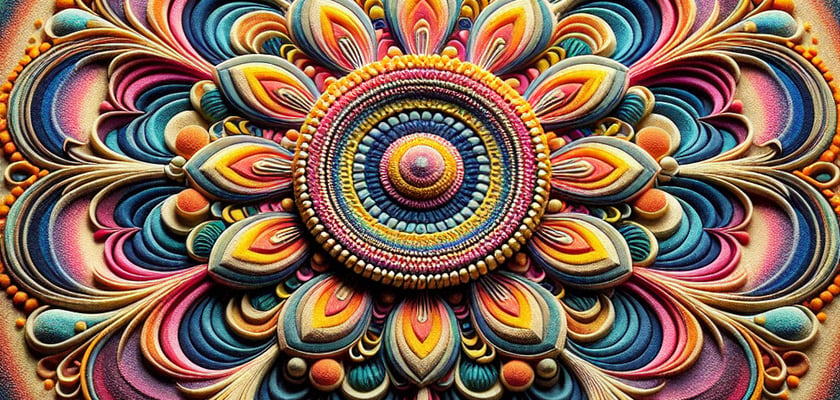Let’s dive into the vibrant world of colorful sand paintings, the unsung heroes of art that don’t need your fancy-schmancy oil paints or posh canvas to be breathtakingly beautiful. Picture this: grains of sand that have decided to have a kaleidoscopic party on a flat surface. This art form, rooted in ancient practices, is an intricate dance of colors, crafted meticulously by placing individual grains of sand to create an image that screams, “Look at me, I’m fabulous!” Mind-boggling patience and a steady hand are the secret sauce behind these mesmerizing masterpieces, with each tiny soldier of sand falling into place to form everything from tribal tales to modern geometric wonders. It’s an express train to Impress-ville with colorful sand art as your one-way ticket.
Now, before we zoom off to the next stop on this journey, buckle up because we’re about to explore the magical alleyways that make colorful sand paintings an unforgettable spectacle. We’re not talking run-of-the-mill art class projects here; we’re talking sand that’s been jazzed up with every color of the rainbow, maybe even colors the rainbow wishes it had. Next up on our gallery walk, you’ll be brushed up with the key takeaways about the technicolor techniques that make these sandscapes sing and why they might just be the next big thing to add a splash of pizzazz to your dull living room wall. We’ll dive into the nitty-gritty – well, sandy-gritty – details of how to create your own granular Van Gogh, and who knows, by the end of it, you might just be a sand-slinging art wizard with more flair than a peacock at a pride parade. Stay tuned for a pinch more of sand-tastic insight!
Key points I covered in this post
1. Colorful sand paintings are a form of art that utilizes fine grains of sand as the primary medium. This technique involves carefully placing colored sand on a surface to create intricate patterns, images, or scenes, often requiring immense skill and patience. The vibrant hues and the potential for detailed work make sand painting a unique and eye-catching art form.
2. The origins of sand painting are deeply rooted in cultural and spiritual practices. Various indigenous communities, particularly Native Americans like the Navajo, have long used sand paintings for religious ceremonies and healing rituals. Each color and symbol within these paintings carries specific meanings and intentions, which are integral to the practices of these cultures.
3. Sand painting has evolved over time and has been adapted by artists around the world, allowing for a broadening of its traditional uses. In contemporary settings, sand art can be both permanent and temporary. While some artists seal their work with adhesives to preserve them, others view the intrinsic ephemerality as part of the art’s beauty, leaving their creations to be dismantled after completion.
4. Creating sand paintings involves more than just the application of sand. Artists must consider factors such as the granule size, the adherence of the sand to the surface, and the choice of tools to manipulate the sand. Mastery in controlling these variables is essential to achieve the desired precision and detailing in the artwork.
5. The process of making sand paintings often has a meditative aspect, with the artist entering a state of deep focus and contemplation. This reflective practice can be as beneficial to the artist’s well-being as it is to the creation of the art itself, with many artists expressing a sense of peace and accomplishment during and after the process.
What Are the Techniques Used in Colorful Sand Paintings?
In crafting colorful sand paintings, artists meticulously layer sand, grain by grain, using tools like chisels, funnels, and brushes. Each hue is carefully placed, often with the aid of templates and adhesive surfaces to ensure the granules stay put, resulting in vibrant, textured works that showcase both the fluidity and precision of this unique art form.
Materials and Tools for Sand Art
High-quality, colorful sand is the primary material used in sand painting. The sand can either be naturally colored or dyed to achieve a broader spectrum of shades. Various tools are essential, such as funnels for controlled pouring, straws or tubes for blowing techniques, brushes for subtle adjustments, and chisels for precision work. Adhesives like glue or a clear fixative are applied to the surface to secure the sand, while binders may be integrated into the sand to enhance color fastness.
Color Selection and Palette
The choice of colors plays a pivotal role in the outcome of a sand painting. Artists often select their palette based on the subject matter and desired emotional impact. Complementary colors can create a vibrant contrast, while analogous colors render harmonious transitions. A deep understanding of color theory is necessary to predict how individual grains will blend at a distance, shaping the overall aesthetic.
Traditional and Modern Designs
Sand paintings bear cultural significance, with traditional designs rooted in spiritual and healing ceremonies, particularly within Native American communities. These historical patterns often depict symbolic imagery and storytelling. In contemporary art, however, sand painting has expanded into various styles, from abstract forms to realistic sceneries. In both contexts, the emphasis on geometrical patterns, symmetry, and iconography remains central.
Creation Process
The creation of a sand painting follows a multi-step procedure. Initially, artists sketch the outline of the intended design on a surface. Following this, one color at a time is applied, working from the background to the forefront to build up layers and depth. The painting process is labor-intensive, requiring a steady hand and rigorous attention to detail in order to avoid muddling the meticulously placed grains.
Preservation and Display of Sand Art
Preservation of colorful sand paintings is crucial due to their delicate nature. Once the piece is finalized, a fixative may be applied to secure the sand in place. Framing behind glass is common to protect the artwork from touch, moisture, and air currents. Proper lighting can greatly enhance the colors and shadow play, accentuating the texture in the sand work. Climate-controlled environments help in preserving the integrity and vibrancy of the painting over time.
Educational and Therapeutic Uses
Beyond their aesthetic value, colorful sand paintings are used in educational settings to teach about color theory, art, and cultural history. They also have therapeutic applications, often utilized in art therapy sessions to promote mindfulness, relaxation, and an outlet for emotional expression. The tactile, immersive nature of creating with sand can aid in improving fine motor skills and cognitive function.
How Can You Get Involved in Sand Painting?
Starting with sand painting can be both accessible and rewarding. It’s recommended to begin with basic kits that include pre-dyed sand, rudimentary tools, and patterns to follow. As skills develop, aspirants can experiment with mixing sand colors and designing original compositions. Local workshops or online tutorials provide guidance on techniques and styles, while art communities and forums offer platforms for sharing work and receiving feedback.
What Are Some Tips for Those Interested in Colorful Sand Painting?
- Select high-quality, fine-grain sand for more precise details and a better color payoff.
- Invest in the proper tools such as fine-tipped funnels, miniature rakes, or brushes to meticulously maneuver sand into place.
- Practice basic techniques on smaller scales before attempting larger, more complex pieces.
- Study color theory to understand how colors interact with each other and what emotions they can convey.
- Take inspiration from traditional patterns but don’t shy away from experimenting with your own designs.
- Keep a steady hand and be patient; sand painting is a time-intensive art that cannot be rushed.
- Learn proper preservation techniques to maintain the vibrancy and integrity of your artwork over time.
How are colorful sand paintings made?
Colorful sand paintings are crafted by carefully layering sand of various colors to create images or designs. Artists use a variety of tools to place the sand precisely, including funnels, tubes, and even their hands. The process requires a steady hand and a great deal of patience, as each layer of sand must be applied without disturbing the underlying or adjacent layers.
What kind of sand is used for sand paintings?
The sand used for sand paintings is typically a fine-grained sand that can hold color well. This sand is often natural, although it may be dyed to achieve a wide palette of colors. The texture and the consistency of the sand are important factors to ensure the sand can create crisp lines and retain its place without scattering.
Can colorful sand paintings be preserved?
Colorful sand paintings can be preserved, although the methods vary depending on the artist’s intention. Some paintings are created as temporary pieces, meant to be enjoyed in the moment and then dismantled. For permanent works, artists may use adhesives or a fixative spray to bind the sand particles together, and the painting may be covered with a glass pane to protect it from disturbances and preserve its vibrant colors.
Is there a cultural significance to sand paintings?
Yes, sand paintings hold cultural significance in various traditions around the world. For example, Tibetan monks create intricate mandalas out of colored sand as a meditative practice and a symbolic representation of transience. In Native American culture, particularly among the Navajo, sand painting is a healing art used in religious ceremonies. Each culture has its unique symbolism and methodology associated with sand paintings.
Are there any tools or kits available for beginners interested in colorful sand paintings?
For those interested in trying their hand at colorful sand painting, there are various tools and kits available. These kits often include a range of colored sands, applicators, and a base to work on. They may also come with guided templates for beginners. These resources are beneficial for learning the basic techniques of sand application and design before venturing into freehand work.
Final Thoughts
Sand painting is a mesmerizing and exquisite art form that spans cultures and transcends the barriers of language through its visual appeal. Whether as a therapeutic activity, a spiritual ritual, or merely a creative expression, the utilization of vibrant sands to weave intricate designs not only exhibits artistic prowess but also narrates stories through its colorful grains.
The practice of creating colorful sand paintings is both an homage to tradition and a testament to the spirit of innovation, as contemporary artists continually evolve the art form. Sand paintings continue to capture our collective imaginations, reminding us of the impermanence of life and the beauty that can be crafted from simple, earthly elements.

